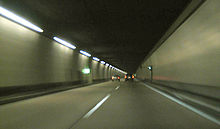Seelisberg tunnel
| Seelisberg tunnel | ||
|---|---|---|
|
North portal
|
||
| use | Road tunnel | |
| traffic connection | A2 motorway | |
| place | Seelisberg | |
| length | 9292 m | |
| vehicles per day | 20 990 (2016) | |
| Number of tubes | 2 | |
| Largest coverage | 1400 m | |
| construction | ||
| start of building | 1971 | |
| business | ||
| operator | Federal Roads Office | |
| release | December 12, 1980 | |
| location | ||
|
|
||
| Coordinates | ||
| North portal (Rütenen) | 681748 / 201933 | |
| South portal (Büel) | 687833 / 195335 | |
The Seelisberg tunnel is part of the A2 motorway between the cantons of Nidwalden and Uri and is therefore an important part of the north-south axis in Switzerland . The north portal is located high above Lake Lucerne near Beckenried NW , the south portal near Bolzbach, Seedorf UR on the west bank of Lake Uri . This tunnel does not get its name from a mountain of the same name, but from the well-known town of Seelisberg UR , which, before the tunnel was built, represented the end of the bypass around Lake Lucerne on the left. The mountain range, which is mainly crossed by the Seelisberg tunnel, is 1923 m above sea level. M. high Niederbauen Chulm . The 9292 meter long Seelisberg tunnel was worldwide and is still the longest double-tube road tunnel in Switzerland today. It was built between 1971 and 1980.
Building
The tunnel has two tubes with a center distance of 25 meters between the portals. In the middle section the distance increases up to 60 meters. In the two-lane tunnel tubes, the clearance height is 4.5 meters, the carriageway width is 7.5 meters, plus 0.8 meter-wide sidewalks on both sides. There are cross connections between the tubes as escape routes every 300 meters.
The tunnel tubes are ventilated via four underground centers, two of which are at the portals Rütenen (near Beckenried) and Büel (near Seedorf). There is also the Hattig middle station, which sucks in the supply air through a 275 meter high shaft and blows out the exhaust air, and the Huttegg middle station, which has a 640 meter long tunnel and a 189 meter high shaft for air exchange.
Manufacturing
The two tunnel tubes were built in three construction lots. Lot Rüttenen (Lot North) comprised 2 × 4,300 meters of tunnels and the Rütenen and Hattig ventilation centers. It had its point of attack for the tunnel driving at the north portal. Lot Büel (Lot South) with the point of attack at the south portal comprised 2 × 2900 meters of tunnels and the Büel ventilation center. Both lots had a horseshoe profile with an area of 88 to 125 m² as excavated cross-section and were constructed using blasting. Lot Huttegg (middle lot) comprised 2 × 2000 meters of tunnel and the Huttegg ventilation center. The point of attack was the later ventilation tunnel. The driving of the circular profile with an area of 111 to 115 m² was carried out with an American tunnel shield with a rake tooth excavator and a segment placing machine . A maximum of 230 miners worked in the tunnel.
traffic
The tunnel is used by around 20,000 vehicles a day. It is approved for a displayed maximum speed of 100 km / h. In contrast to most other road tunnels in Switzerland, the roadway consists of concrete slabs. Despite its length and monotony, there were hardly any accidents worth mentioning. Half of the few fatal accidents occurred with oncoming traffic due to the blocking of the other tube.
literature
- Jules Jakob, Reto Zobrist, Peter Püntener and others: On the opening of the Seelisberg road tunnel. In: Kurt Meyer (Red.): Swiss engineer and architect . Issue 50/80, year 98, December 11, 1980, ISSN 0251-0960 . Verlag AG of the Academic Technical Associations, Zurich 1980, pp. 1235–1325. doi: 10.5169 / seals-74266 (full text).
Individual evidence
- ↑ Swiss Automatic Road Traffic Census (SASVZ) - monthly and annual results 2016. Federal Roads Office , October 19, 2017, accessed on December 19, 2018 .


